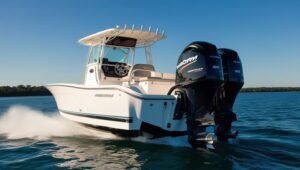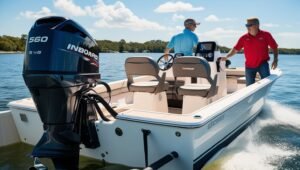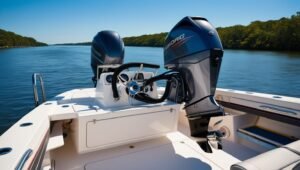
Which of the following maintenance is recommended for an inboard boat?
Inboard boats are a popular choice for boating enthusiasts due to their superior handling, power, and overall performance. However, to operate these boats efficiently and safely, regular maintenance is essential. Whether you’re an experienced boater or a novice, understanding the recommended maintenance for your inboard boat will ensure that it stays in top condition and prolongs its life.

Understanding Inboard Boat Maintenance
Before diving into the details of in-house boat maintenance, it is important to understand the unique aspects of these vessels. Unlike outboard motors, inboard engines are placed under the boat, usually below deck. This design offers several advantages, including better weight distribution and a quieter ride. However, this also means that maintenance can be more complex, requiring regular attention to various components to prevent problems that can lead to costly repairs.
1 Routine engine checks and maintenance
The heart of your sailboat is its engine, and keeping it in top condition is paramount. Routine engine maintenance should include the following steps:
Regular oil changes
Just like a car engine, the engine inside your boat needs regular oil changes to ensure smooth operation. Check the oil level before each outing and change the oil at least every 50-100 hours of operation or at the beginning and end of each boating season. It is important to use the oil type and filter recommended by the manufacturer to maintain engine health.
Inspection of the cooling system
Inboard engines rely on a cooling system to prevent overheating. This system usually includes a raw water pump, heat exchanger, and hoses. Inspect the cooling system regularly for leaks, cracks, and corrosion. Flush the cooling system with fresh water after each use, especially if you operate in salt water, to prevent salt build-up and corrosion.
Fuel system maintenance
The fuel system is another important area that needs regular attention. Check fuel lines, connections, and filters for signs of wear or leaks. Change the fuel filter annually or as recommended by the manufacturer. It is also wise to use a fuel stabilizer during storage to prevent fuel degradation.

2 Inspection and maintenance of electrical system
The electrical system in an inboard boat powers everything from the engine to the navigation lights. Ensuring that electrical components are in good working order is critical to safe and reliable operation.
Battery maintenance
Inboard boats typically have one or more batteries to power the engine and onboard electronics. Check the battery connections regularly for corrosion and make sure they are secure. Clean off any corrosion with a mixture of baking soda and water. If your battery is more than three years old, consider having it checked or replaced.
Inspection of wiring
Your boat’s wiring is susceptible to wear and tear, especially in marine environments. Inspect all wiring for signs of fraying, corrosion, or loose connections. Pay special attention to areas where wiring passes through bulkheads or other tight spaces. Replace any damaged wiring immediately to avoid electrical damage.
3 Maintenance of propeller and shaft
Propellers and shafts are the main components that convert engine power into motion. Regular maintenance of these parts is essential to ensure efficient operation and prevent engine damage.
Propeller inspection and maintenance
Inspect the propeller for any damage, such as dings, bends or cracks. A damaged propeller can reduce efficiency and create vibrations that can damage the engine and transmission. If you find a problem, have the propeller repaired or replaced by a professional.
Shaft alignment and inspection
The shaft connects the engine to the propeller and needs to be aligned properly to avoid excessive wear on the engine and transmission. Check shaft alignment regularly and look for signs of wear or corrosion. If the shaft is out of alignment, it can cause vibration and shorten engine and transmission life.

4 Hull and Exterior Maintenance
Your boat’s hull and exterior are constantly exposed to the elements, so regular maintenance is essential to maintain the boat’s appearance and structural integrity.
Plow cleaning and inspection
Clean the hull regularly to remove algae, barnacles, or other marine growth. Inspect the plow for any cracks, blisters, or signs of damage. Address any problems immediately to prevent water intrusion and further damage.
Gelcoat and paint restoration
Gel coats and paints on your boat’s hull protect it from the elements and provide a smooth surface for efficient movement through the water. Inspect the gel coat and paint for any chips, cracks, or fading. Wax the hull regularly to protect the finish and keep it looking its best.
5. Inspection of safety equipment
Safety equipment is essential to protect yourself and your passengers while on the water. Inspect and maintain your safety equipment regularly to ensure it is in good working order.
Life jackets and personal flotation devices (PFDs)
Check all life jackets and PFDs for signs of wear or damage. Make sure they are the right size for all passengers and are easily accessible in an emergency. Replace any damaged or expired life jackets immediately.
Fire extinguishers
Fire extinguishers are an important part of your boat’s safety equipment. Check that all fire extinguishers are fully charged and accessible. Replace anything that has expired or shows signs of damage.
Flares and signaling devices
Flares and other signaling devices are essential to alert others of your location in an emergency. Check the expiration dates on all flares and replace them as needed. Ensure that all signaling devices are in good working order and stored in an easily accessible location.
6. Winter and off-season maintenance
Properly winterizing your on-board boat is very important to protect it during the off-season. Ignoring this step can lead to expensive repairs and shorten the life of your boat.
an Engine winterization
To prevent freezing and corrosion, flush the engine with fresh water and add antifreeze to the cooling system. Change the oil and oil filter, and add a fuel stabilizer to the fuel tank.
Preparation for storage
Clean the boat both inside and out to prevent mold and mildew during storage. Remove any electronics, batteries, and valuables, and store them in a dry, temperature-controlled environment. Cover the boat with a high-quality cover to protect it from the elements.

The result
Regular maintenance is essential to keep your boat running smoothly and to ensure your safety on the water. By following these recommended maintenance practices, you can enjoy many years of trouble-free boating. Remember, the key to a long-lasting boat is consistent maintenance and attention to detail.
